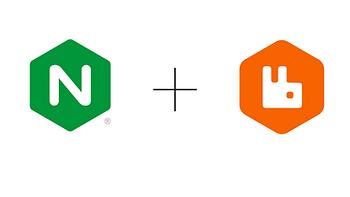Building a Message Queue with NGINX and RabbitMQ
Simple guide to configure nginx with rabbitmq

Hey there tech enthusiasts!
Ever wondered how you can seamlessly integrate NGINX, the powerful web server, with RabbitMQ, the robust message broker? Well, today we’re going to walk you through the process in a way that’s easy to follow and understand.
Understanding NGINX and RabbitMQ
NGINX is a lightweight, high-performance web server and reverse proxy server. It is designed to handle a large number of concurrent connections and deliver content quickly and efficiently. NGINX can also be used as a message queue broker by leveraging its event-driven architecture and support for non-blocking I/O.
RabbitMQ, on the other hand, is a feature-rich message broker that implements the AMQP protocol. It provides a reliable and scalable platform for message queuing. RabbitMQ supports various messaging patterns such as publish/subscribe, request/reply, and point-to-point communication. It also offers features like message persistence, routing, and delivery acknowledgments.
While both NGINX and RabbitMQ can be used for message queuing, they have different strengths and use cases. NGINX is best suited for scenarios where high performance and scalability are critical, such as handling a large number of concurrent connections. RabbitMQ, on the other hand, is more suitable for scenarios that require advanced messaging features like routing, persistence, and guaranteed delivery.
The Setup
So, let’s break it down. NGINX is going to act as our intermediary. When a client sends an HTTP request, NGINX will swoop in, snatch up the message, and gracefully deliver it to our trusty RabbitMQ queue.
Let’s Get Started!
NGINX Configuration
First things first, we’ll configure NGINX. You’ll need to have the NGINX Lua module installed. Don’t worry, it’s as straightforward as it gets.
# nginx config
worker_processes 1;
events {
worker_connections 1024;
}
http {
lua_package_path "/path/to/your/lua/scripts/?.lua;;";
server {
listen 80;
server_name example.com;
location / {
access_by_lua_file /path/to/your/lua/scripts/handle_request.lua;
proxy_pass http://backend_server;
proxy_set_header Host $host;
proxy_set_header X-Real-IP $remote_addr;
proxy_set_header X-Forwarded-For $proxy_add_x_forwarded_for;
proxy_set_header X-Forwarded-Proto $scheme;
}
}
upstream backend_server {
server backend_server_ip:backend_server_port;
}
}
Lua Script Magic
Next up, our Lua script. This little marvel will be responsible for handling the request and sending it on its merry way to RabbitMQ.
# lua code
local cjson = require "cjson"function send_to_rabbitmq(message)-- Add your RabbitMQ logic hereendlocal request_body = ngx.req.get_body_data()
if request_body thenlocal message = cjson.decode(request_body)
if message then
send_to_rabbitmq(message)
endend
Securing Message Queues with NGINX and RabbitMQ
Securing message queues is crucial to protect sensitive data and prevent unauthorized access. NGINX and RabbitMQ provide various security features that can be used to secure message queues.
To secure NGINX, you can enable SSL/TLS encryption to encrypt the communication between clients and the server. This helps to prevent eavesdropping and ensures the confidentiality of the data being transmitted. NGINX also supports client certificate authentication, which allows you to authenticate clients based on their digital certificates.
To secure RabbitMQ, you can enable SSL/TLS encryption for the communication between clients and the broker. RabbitMQ supports various authentication mechanisms, such as username/password authentication, LDAP authentication, and OAuth 2.0 authentication. You can also configure access control lists (ACLs) to restrict access to specific queues or exchanges based on user roles and permissions.
Monitoring and Debugging Message Queues with NGINX and RabbitMQ
Monitoring and debugging message queues are essential for identifying performance issues, detecting bottlenecks, and troubleshooting problems. NGINX and RabbitMQ provide various tools and techniques for monitoring and debugging message queues.
NGINX provides a built-in monitoring module called ngx_http_stub_status_module, which allows you to monitor the status of NGINX and view various metrics such as active connections, requests per second, and response time. NGINX also integrates with third-party monitoring tools like Prometheus and Grafana, which provide more advanced monitoring capabilities.
RabbitMQ provides a management interface that allows you to monitor the status of the broker and view various metrics such as message rates, queue lengths, and connection counts. RabbitMQ also integrates with third-party monitoring tools like Prometheus and Grafana, which provide more advanced monitoring capabilities.
Scaling Message Queues with NGINX and RabbitMQ
Scaling message queues is important to handle increasing workloads and ensure high performance. NGINX and RabbitMQ provide various techniques for scaling message queues.
To scale NGINX, you can add more servers and configure them as backend servers in the NGINX configuration file. NGINX can distribute incoming requests across multiple backend servers using load balancing algorithms, ensuring that the workload is evenly distributed and no single server becomes a bottleneck.
To scale RabbitMQ, you can add more instances and configure them to form a cluster. RabbitMQ clusters provide high availability and scalability by distributing the workload across multiple nodes. Each node in the cluster can handle incoming requests and replicate messages to other nodes, ensuring that the message queue remains accessible even if some nodes fail.
Wrapping it Up
And there you have it! With NGINX and RabbitMQ working in tandem, you’ve created a seamless pipeline for handling messages. NGINX takes care of the heavy lifting, ensuring your messages get to their destination smoothly.
Remember, this is just the beginning. You can customize and expand upon this setup to suit your specific needs. The possibilities are endless!
So go ahead, give it a try. Your message queue awaits! 🚀

Add comment
@name